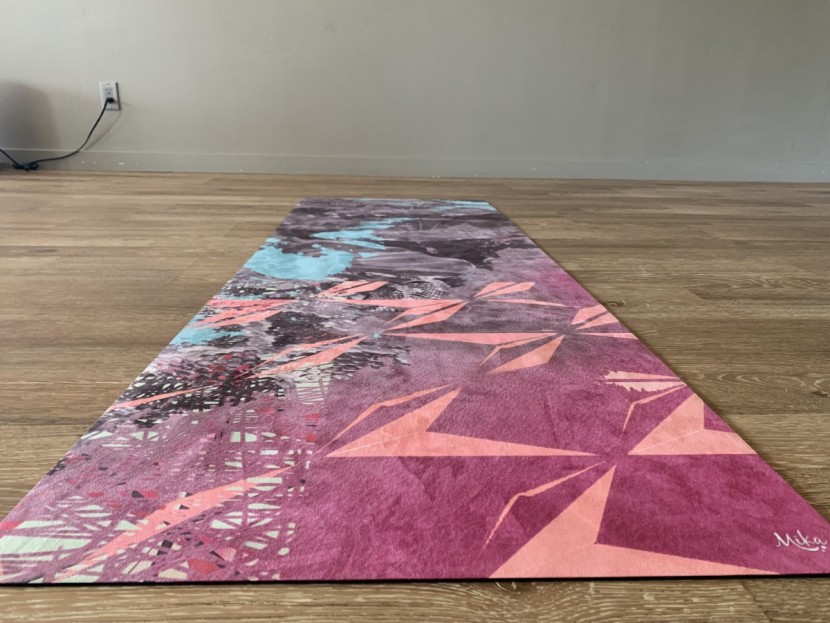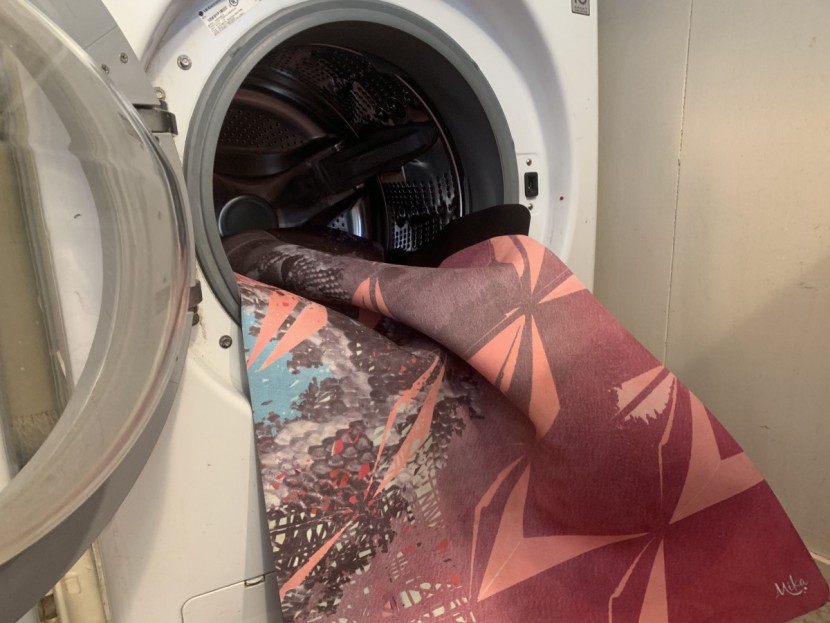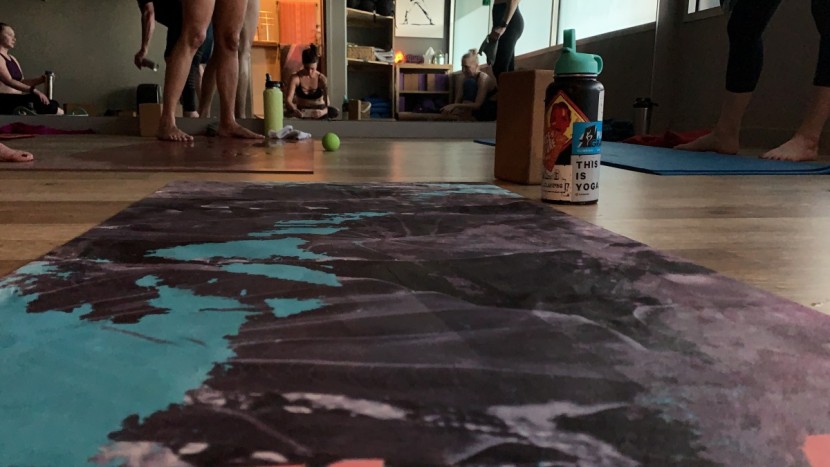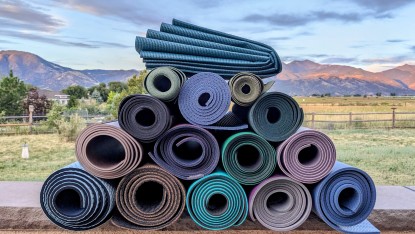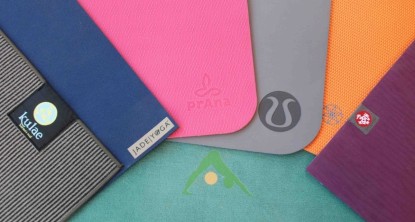Mika Mat Review

Our Verdict
Our Analysis and Test Results
Mika is a beautifully designed mat that can be purchased in many different patterns. It's high-quality, but can be challenging to care for and lug around. While it's on the cheaper side for a mat, we do think there are better on the market.
Ease of Care
The Mika can be challenging to clean. This mat does not have a rubber smell, especially compared to the Lululemon Travel Mat and the Manduka eKO. However, when this mat is drenched in sweat, a fairly strong rubber smell is present. We also found that if you do not diligently wipe down and hang dry Mika overnight, your sweat smell will linger, and it will not dry properly (if you're a sweaty person). Out of all the mats we tested, the Mika took the longest to dry. After a hot, sweaty class, it is crucial to hang dry the mat overnight.
Compared to the other mats we tested, this mat needed the longest amount of time dry. Mika has a microfiber faux-suede top, which is supposed to act as a hot yoga towel, specifically for hot practices. When wet with sweat, it feels similar to a damp towel, and it feels slippery and slimy. Compared to using a mat towel, it's not as easy to throw into a plastic bag at the end of practice. It's best to fold it and immediately hang dry at home.
Mika suggests popping it in the washing machine if it holds on to your stink. We put that advice to the test and found the Mika can indeed withstand the washing machine. However, it accentuates the rubber smell after it comes out.
Traction Dry
Mika prides itself in saying it is a mat/towel combination. Similar to using a yoga mat towel, this mat is slippery when dry. Spreading water on the mat before practice with a water bottle or spray bottle creates more traction for a safer practice. Without any water for an adequate amount of traction, practicing poses that require a lot of pressure on your hands or feet (such as down-dog, side plank, or backbends) become difficult, and even dangerous, if you have any injuries. Because the Mika mat does not have much traction when dry, we would not recommend this mat for a regular practice that is not in a heated studio.
Traction Wet
Mika's website recommends you spray the mat lightly with water before practicing on it. We found this to be necessary, especially if you're heading into a hot yoga class. When the Mika is wet, it has a considerable amount of traction. When some of our sweatier reviewers put this to the test, the mat was once again slippery by the end of practice. If you are a considerably sweaty person, this mat becomes just as slippery as when it is dry.
According to Active.com “an average person sweats between 0.8L and 1.4L an hour.” We put that to the test! Gradually we added more and more water and tried down dog, a high-pressure yoga pose, to see when the mat became too slippery to practice on. For a person who sweats about 0.8L per hour, as most people likely do, this mat is perfect, as traction will be maintained throughout the whole practice.
However, for a person sweating at 1.4L per hour, this is not the mat for you. At 0.5 L, this mat becomes slippery again. During testing, the Mika got especially slippery after floor work due to all the sweat from our body. After that point, the mat became very slimy and challenging to practice on.
Comfort and Stability
The Mika has just enough cushion so that it is comfortable on your knees when doing floor work, but not so cushiony that it is challenging to balance. The weight of the mat also helps the mat to lay down very nicely on the floor, making it easy to perform balancing postures.
The best kind of mat is one that you hardly think about during practice. It is common for some mats to move around, making your yoga practice more about keeping your mat stable than the yoga itself. Mika passed this test with flying colors. Weighing in at 5 pounds 3 ounces, it remained flat and did not budge on any surface. This can also be attributed to the very grippy eco-friendly rubber bottom.
Durability
Mika is a durable mat in that the material is of good quality, and our reviewers found that it'll see you through many classes. However, if you are the type of yogi getting to the mat multiple times a week, we'd recommend looking elsewhere, like the Guru Grid or Yohola. Caring for this mat is time-consuming, and if not properly cared for, its longevity may become reduced.
We appreciate the beautiful colors and patterns that this mat is available in. Mika uses all-natural water-based dyes to make their mats pop; we imagine that due to the inks being water-based, they tend to fade when the mat is used frequently.
Portability
Mika weighs 5 pounds 3 ounces, which is on the heavy side. When it gets wet, excess weight is added, dependent upon how much you sweat. Because of the weight and material, it would not be an excellent candidate to take on your next trip (unless it's a road trip).
The Mika is not a mat you'd want to leave in your car or at the yoga studio after a sweaty practice. As far as portability goes, you'll want to take the Mika home with you after practice and clean accordingly. If you're a sweaty person and an adequate cleaning regime is not followed, it will not dry properly and will retain smells.
Value
The Mika is average in cost. While the Mika can be great for hot yoga, we'd point you in the direction of the Lululemon models, or the Yoloha Native Mat. For some, time is money, and the maintenance may be too much.
Conclusion
The Mika Mat is beautiful in color and has decent traction when wet; however, that traction dissipates when the mat becomes too wet. The biggest downside is how difficult it is to maintain. It's not the ideal choice for someone with a long commute or riding to class on their bike, as it's considerably heavy and becomes even heavier after a sweaty practice. If you do buy this mat, we recommend cleaning it in a washing machine once a week.



